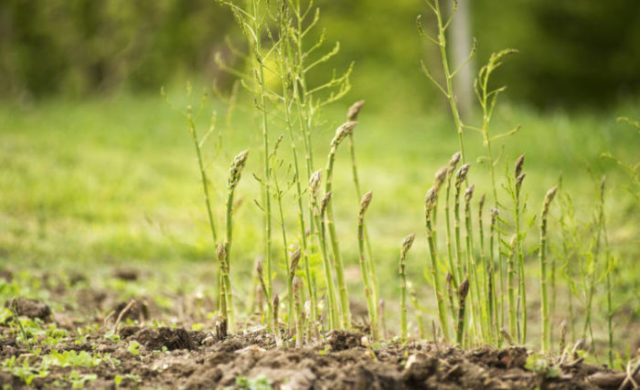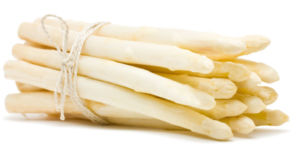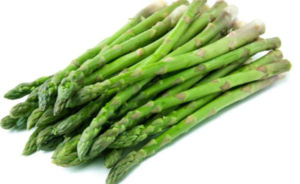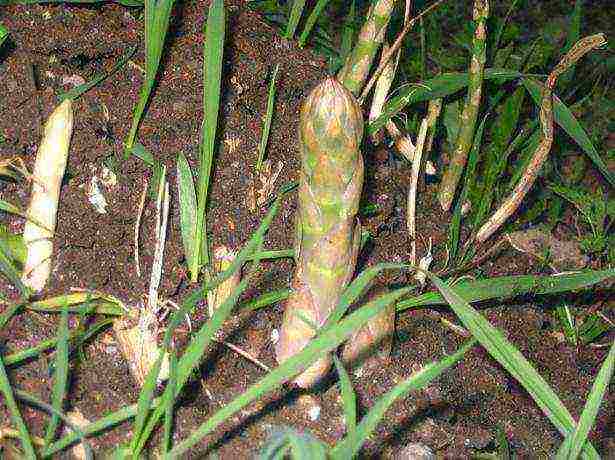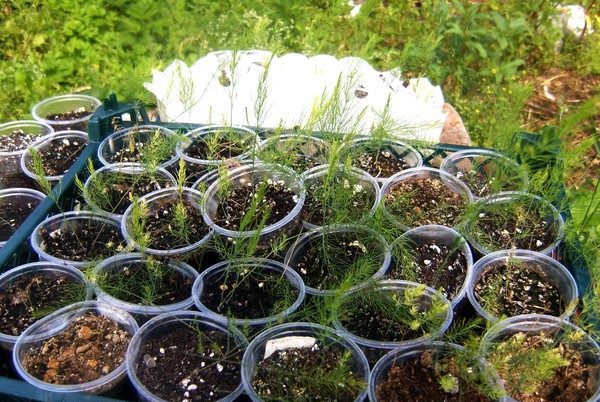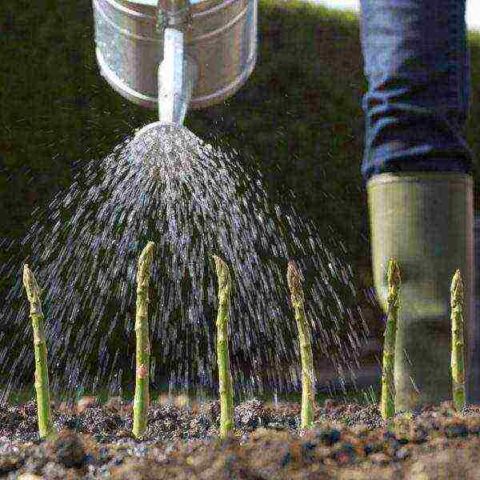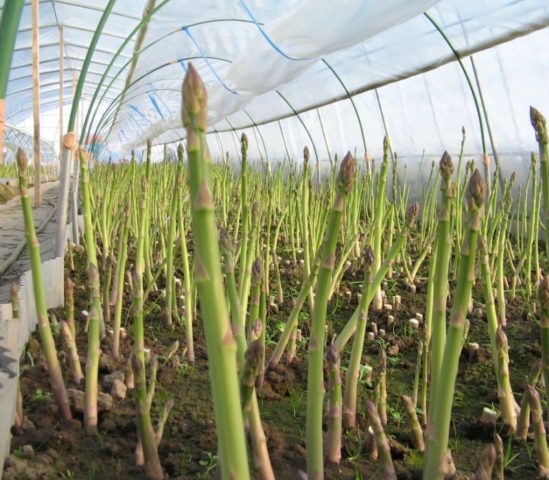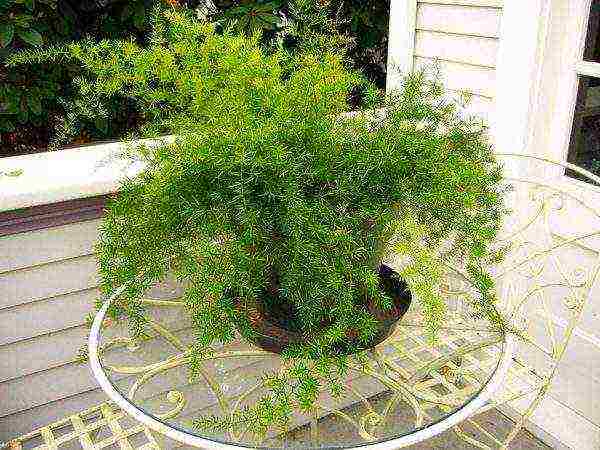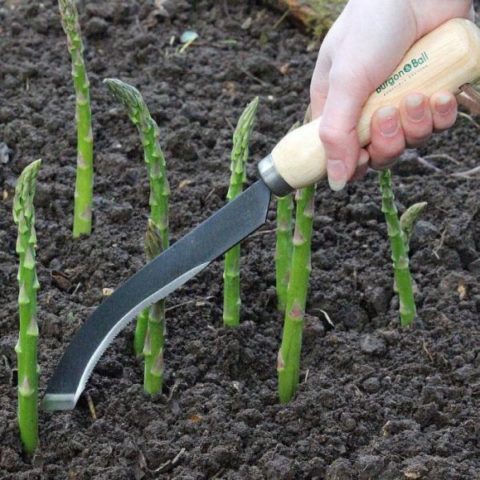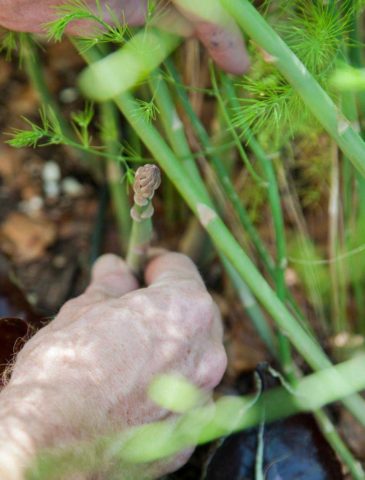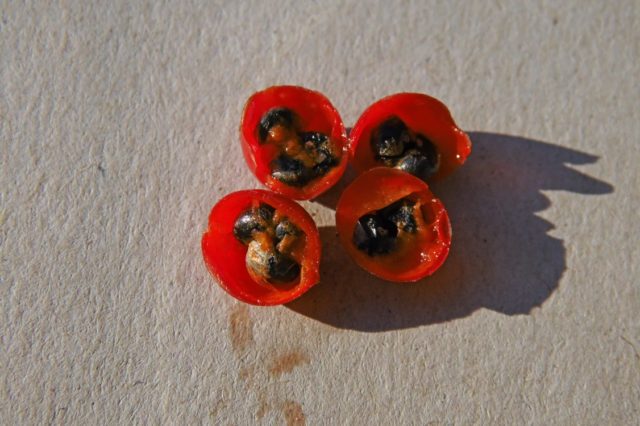Content
- 1 Where does asparagus grow
- 2 Is it possible to grow asparagus
- 3 How asparagus grows in the garden
- 4 How to grow asparagus outdoors
- 5 How to plant asparagus seedlings
- 6 How to plant asparagus outdoors
- 7 How to care for asparagus outdoors
- 8 Growing asparagus in a greenhouse
- 9 Features of growing asparagus in different regions
- 10 Growing asparagus at home on a windowsill
- 11 Harvesting and storage
- 12 How asparagus reproduces
- 13 Diseases and pests
- 14 Conclusion
- 15 Reviews on the cultivation of asparagus
Growing and caring for asparagus outdoors requires some knowledge. The plant is considered a vegetable. They eat dense shoots, which, depending on the variety, are green, white, purple. For treatment, traditional healers use roots. Beautiful bright orange berries are usually used for decorative purposes.
Where does asparagus grow
Asparagus grows in almost all countries. The plant tolerates heat and cold well. Large plantings of vegetables are found in European countries, Asia, Africa and on the territory of the Russian Federation. The plant is considered perennial. In one place, without transplanting, asparagus can grow up to 20 years. The vegetable is not afraid of frosts, but it can be destroyed by sudden frosts.
Is it possible to grow asparagus
If desired, any gardener is capable of growing a garden culture. The vegetable grows well in the greenhouse, in the garden and on the windowsill. However, indoor cultivation is likely to produce an ornamental plant. Asparagus has a very long root. It is difficult to provide conditions in the house for a full-fledged vegetable suitable for eating to grow.
How asparagus grows in the garden
The garden culture loves a sunny area, nutritious soil that is not overgrown with weeds. The vegetable grows well on sandy soil. Asparagus needs a lot of free space. The site for planting is chosen from the southern side, closed from blowing by the wind. The soil is acceptable non-acidic with a lot of humus. Externally, the growing asparagus resembles bushes with pods. Shoots or stems can grow.
According to external signs, a vegetable is of three types:
- White asparagus grows underground. In terms of taste, it is placed in the same place as truffles or artichokes. The technology of growing a garden crop requires constant hilling. The complexity of the process affects the high price of the finished product. However, white pods have many beneficial substances, for which vegetarians are valued.
- Green asparagus more common in England, as the local climate suits it better. The pods have a pronounced taste, are rich in vitamins B and C. The harvest time of the garden crop lasts from spring to mid-summer.
- Purple asparagus it acquires its unusual shade from exposure to sunlight. During cooking, the pods restore their natural green color. The vegetable grows in any garden bed, tastes a little bitter. If shoots are not collected in time, they become rough.
Each type of asparagus requires certain growing conditions, loves different soil, weather conditions.
How to grow asparagus outdoors
The whole process of planting asparagus in the open field and caring for it does not require sophisticated technology. The garden crop is grown like a regular garden vegetable. Propagated by seedlings or dividing the bush. Briefly, the process can be described by several actions:
- Seeds are sown in the garden in early spring. The holes are made 3 cm deep with an indent from each other of about 30 cm. If the garden crop is planted with seedlings, then it is observed that the upper buds are level with the ground.
- With any method, before planting the crop, the soil in the garden bed is abundantly fertilized with compost.
- Plant care consists of standard steps. The bed is loosened, kept clean of weeds. As the soil dries up, watering is carried out. Three dressings are made per season.
If the place and soil were initially correctly selected for a garden culture, it will grow up to 20 years. The yield will maximize from the sixth year.
How to plant asparagus seedlings
Most often, for the successful cultivation of crops, gardeners carry out sowing of asparagus for seedlings. The technology is more in demand in cold regions, where frosts still persist in spring.
When to sow asparagus for seedlings
The exact time of sowing seeds of a garden crop depends on the climatic conditions of the area. Usually this period falls on March-April. The gardener individually determines the timing by analyzing the weather of past years.
Preparation of planting tanks and soil
Containers for seedlings are boxes, cups, flower pots. They must be disinfected with a manganese solution or other store-bought preparations.
The soil is prepared light. Seedlings love to have abundant air penetration to the roots. If you use store-bought soil, then add 1 part of sand and 1 part of vermiculite or coconut substrate to 5 parts of it.
Seed preparation
A feature of garden crop seeds is difficult germination. It takes them a long time to hatch. Optimally, before sowing, place the seeds in a solution of any biostimulant, for example, Epin, and keep them there for 2 days.
You can use ordinary warm water for soaking, but the duration of the process is increased to 4 days. Moreover, the water in the soaked seeds is changed 2 times a day. It is important to maintain the same temperature for 4 days. Such parameters can be achieved if the container with seeds is kept in a warm place.
The soaked seeds are spread on a damp cotton cloth, left in a warm place until sprouts appear. Pecking will begin in about a week.
Planting asparagus for seedlings
Usually, growing asparagus from seeds in the country is carried out in containers. The process consists of the following steps:
- the container is filled with soil, lightly compacted by hand;
- without making grooves, the seeds are simply laid out on the soil surface in 3-4 cm steps;
- sprinkle the grains on top with loose soil 1 cm thick;
- crops are moistened from a sprayer;
- the container is covered with glass or transparent film, placed in the light in a warm place.
In order for germination to proceed faster, it is necessary to constantly maintain warmth and moisture. Drops will accumulate on the inside of the shelter. Once a day, the film or glass is lifted for ventilation. Maintaining a temperature of + 25 ° C around the clock, the sprouts will appear in 1.5 months.
In the video, sowing seedlings:
Seedling care
After mass sprouting, the sprouts of the garden culture are not completely sprinkled with dry peat. In the interval between 10-15 days, fertilizing is carried out with a complex fertilizer. Water the seedlings, carefully loosen the soil, turn the container on different sides to the light every day. In about a month, the stems will grow 15 cm high. The crops are thinned out. The strongest plants should remain at a distance of 10 cm from each other.
The hardening of asparagus seedlings begins at the end of May. At first she is kept on the street for 1 hour. The time is increased daily until it reaches 12 o'clock.
How to plant asparagus outdoors
The process of growing asparagus in the garden begins with planting seedlings. At this point, the culture has passed the stage of hardening, ready to face the open ground.
Planting asparagus in the garden
Planting asparagus, like most garden crops, is best done in warm soil. At this point, the time for recurrent frosts should have passed. In most regions of the Russian Federation, the beginning of June is considered the optimal time for planting seedlings. In the south, you can plant earlier.
Landing site preparation
A garden bed is prepared in a sunny area. If the soil is poor, during digging, 1 bucket of humus is added per 1 m2, mineral complexes are added according to the instructions. Clay soil is considered difficult for the plant. During the digging of such a site, sand is brought in.
Seedlings can be planted not only in spring but also in autumn. In the second case, during the enrichment of the soil, the mineral complexes are replaced with a fertilizer containing phosphorus and potassium. Nitrogen fertilizers should not be applied in the fall. Rapid growth of shoots before winter is not needed.
How to plant asparagus outdoors
There are two ways to plant a garden crop: seeds or seedlings.
Planting asparagus seeds outdoors
If the sowing method is chosen, then on the prepared bed, cut grooves 5 cm deep with a stick or the tip of a hoe. The seeds that have been soaked are sown thickly. Many of them will not germinate. It is better to break through excess shoots later. The seeded grooves are covered with a thin layer of loose soil, lightly slapped with a palm. Garden crops are watered with warm water. After absorbing the liquid, the bed is mulched. Seeds germinate for a long time. They need warmth and moisture. Covering the beds with white agrofibre helps to provide a good microclimate for crops.
Planting asparagus seedlings
For planting seedlings, the depth of the grooves in the garden bed is increased to 30 cm. It is important to take into account that for 20 years of life in one place, the bushes of the garden culture will greatly grow. If a vegetable transplant is not expected in the future, then the seedlings in a row are placed in a step of 40 cm.The row spacing is left at least 1 m wide.
After cutting the grooves, mounds are formed from the fertile soil at the bottom. Saplings are placed on them with roots, sprinkled with loose soil, pressed by hand. If the roots are long, they are shortened with scissors. The optimal length of the branching of the rhizome is 5 cm. After planting the seedlings, the groove is poured abundantly with water, covered with mulch from peat or sawdust.
How to care for asparagus outdoors
A simple agricultural technique for growing asparagus requires doing the usual work for a gardener. The culture requires timely watering, feeding, weeding from weeds.
Watering and feeding
The garden culture does not tolerate excess moisture in the ground, but the seedlings must be watered often. The first two weeks after planting, the plants are watered abundantly to speed up root formation. Immediately after absorbing water, the soil is loosened. If this is not done, the resulting film will block the access of oxygen to the roots. Seedlings need to constantly maintain moist soil, and adult plants are watered less often. However, the soil should not be allowed to dry, otherwise the shoots will acquire bitterness.
Fertilizing the culture is definitely needed, since the yield depends on it. The plant practically does not need nitrogen. Copper and potassium are needed, as these substances affect the juiciness of the shoots. Organic and herbal infusions are considered the best fertilizers.
During the season, asparagus requires three dressings:
- The first feeding of a garden culture in the spring is done with organic matter. Dry granules of potassium, phosphorus and calcium are poured from mineral fertilizers, and then watered abundantly.
- The second feeding falls on July. Asparagus is poured with a solution of chicken manure in a high concentration of 1/10.Top dressing gives strength to the plant after harvest.
- The final third feeding of the culture is done in the fall at the end of October. 30 g of superphosphate and potassium salt are added per 1 m2.
Organic matter makes asparagus shoots tender, tasty, and gives them a white color. Experienced vegetable growers applied in spring or autumn with the appearance of sprouts to fill each plant with a bucket of humus.
Pruning
After planting seedlings, shoots will appear in the garden. You cannot cut them off. The asparagus should grow into openwork bushes. In the second year, pruning is undesirable. In extreme cases, you can cut 1-2 shoots. Full pruning of the crop is carried out in the third year. Shoots with a height of about 12 cm are subject to cutting. Sanitary pruning of the plant is carried out in the fall. All yellowed shoots are cut off, leaving hemp 2.5-5 cm above the ground level.
Transplanting asparagus
Transplanting asparagus to a permanent place is carried out in May. They do this in the second year of life. You can transplant the garden culture in September, so that the plant grows even stronger over the summer. A garden bed is being dug under the landing. 4 buckets of compost are added per 1 m2. The depth of the trenches for spring planting is made in half a shovel bayonet. If the culture is transplanted in the fall, the grooves are dug deep into the bayonet.
25 g of mineral complexes are added under each plant. You can sprinkle 70 g of fertilizer on 1 m of the trench. At the bottom of the grooves, mounds are formed from the soil, asparagus is rooted, and covered with earth. After transplanting, the plants are watered abundantly.
Preparing for winter
In order for the asparagus to overwinter well, in the fall, before the onset of frost, the shoots are cut shortly. The hemp protruding from the ground is covered with soil, forming a hill. Peat or compost is additionally poured on top.
Growing asparagus in a greenhouse
Greenhouses can be used to grow asparagus from seed at home. However, not all varieties can be sown. Early maturing hybrids are most suitable, for example: Connovers Colossal, Franklin, Arzhentelskaya and others. The advantage of greenhouse crop cultivation is early harvests. Asparagus does not require artificial lighting. The plant has enough natural light. The temperature is maintained in the range from + 15 to + 20 ° C. Watering is carried out less often, since moisture evaporates less in the greenhouse. Top dressing and other procedures are performed in the same way as when growing a vegetable in the open field.
Features of growing asparagus in different regions
Asparagus grows in all regions except the far north. For cold areas, it is optimal to leave male plants in the garden. They are distinguished by increased frost resistance. Female plants are more thermophilic.
Growing asparagus in the Moscow region
Specially for the climatic conditions of the Moscow region, asparagus varieties have been bred. The most popular are Early Yellow, Harvest 6, and Danish White. The varieties are well suited for the climate of Belarus. To get a good harvest, the crop is grown in seedlings.
Growing asparagus in Siberia
Cold-resistant varieties of asparagus can withstand temperatures down to -30 ° C with a small snow cover. They can be grown in Siberia. For the winter, the plants are covered with mounds of earth and a thick layer of manure. Reboiling, organic matter generates heat, from which the rhizomes of asparagus are heated. In the spring, until a positive air temperature is established, a greenhouse is pulled over the garden bed, which protects the young shoots of the vegetable from frost.
Growing asparagus in the Urals
The agrotechnology of growing crops in the Urals is the same as for Siberia. In the fall, more mulch, in the spring they set up a greenhouse.
Growing asparagus in the Leningrad region
For the entire middle zone, including the Leningrad region, the cultivation technology and varieties are used the same as for the Moscow region. The climate is about the same.
Growing asparagus at home on a windowsill
The crop is intended for planting in a greenhouse or in a vegetable garden.It will not be possible to fully grow asparagus at home on the windowsill. A long rhizome requires a great depth of the earth, and also strongly branches grow on the sides. In a flower pot, asparagus will grow simply as an openwork ornamental plant.
Harvesting and storage
If the gardener took good care of the asparagus, followed agricultural techniques, the culture will reward with the harvest.
Asparagus yield
The disadvantage is the low yield of the vegetable. Only young shoots are eaten. Depending on the variety and growing time in one place, 2-5 kg of shoots are harvested from 1 m2 of the plot. The first harvesting from a plot of 6 acres will bring about 1200 kg of vegetables. Every year the crop grows in one place, the yield will increase.
When to harvest asparagus
The first crop of a vegetable is harvested only in the third year after planting. However, if the plants are weak, the asparagus harvest is postponed to the fourth year. The maturity of the shoots will be signaled by dense bushes in the garden. The size of the shoot ready for harvesting is about 2 cm thick and up to 20 cm long.
How to harvest asparagus
It is optimal to cut 3 shoots from one bush, maximum - 5 pieces. A special sharpened knife is used to harvest the vegetable. First, they rake the earth around the shoot. The cut is made 3 cm above the rhizome. The remaining stump is covered with peat or compost. In cold regions, shoots are cut every two days. In the southern regions, asparagus grows faster. Shoots are cut 1-2 times a day.
How to preserve asparagus
Asparagus shoots are not subject to long-term storage. On the third day, the vegetable begins to coarse, loses its juiciness. To keep the harvest up to 4 weeks, the shoots need a humidity of at least 90% and an air temperature of 0 ° C. Usually they are wrapped in a wet cloth and sent to the refrigerator. Freezing helps to keep the vegetable longer. The shoots are wrapped with a film or cloth, placed in the freezer.
How asparagus reproduces
There are three ways to propagate a culture. Each gardener chooses the most suitable option for himself.
Propagation of asparagus by dividing the bush
The easiest way is to propagate the crop in the spring and fall. If the summer is not hot, then you can try to perform the procedure at this time of the year. To begin with, dig up an adult bush. Sprouts with full-fledged roots are separated with a knife or hands. Each seedling is planted in the garden in the same way as seedlings.
Similarly, a garden bush can be propagated by rhizomes, dividing it in the spring before young shoots appear. Each root must have 1 bud.
Propagation by cuttings
The breeding method of a culture is complex, it does not always give a positive result. Cuttings are performed from spring to June. Cuttings are cut from last year's green shoots, dipped in a solution of a root growth stimulator, and planted in containers with wet sand. Each seedling is covered with a glass jar or cut PET bottle. Asparagus cuttings are periodically ventilated, sprayed with water. Rooting should take place in 1.5 months.
Seed propagation
Garden crops are planted with seeds for seedlings or immediately in open ground. The breeding method is not very popular, as asparagus seeds do not germinate well. In addition, the gardener has additional difficulty in caring for the seedlings.
Diseases and pests
Asparagus is resistant to diseases, rarely affected by pests, but sometimes unpleasant situations happen:
- The beginning of root rot of a garden culture is signaled by crumbling twigs. The plant is treated with Fundazole or the entire bush is removed.
- In June, rust can attack the shoots of a garden culture. They become dark in color, wounds appear. The fungus is treated by spraying it with a fungicide.
- A dangerous pest of garden crops is the asparagus fly, which lays eggs inside the shoots. The hatched larvae eat the plant. Insecticides help fight the fly. The most popular drug is Actellic.
- The asparagus rattle loves to feed on succulent stems, foliage, and even seeds. Adult beetles are collected by hand. The larvae are destroyed in the soil by adding Actellic.
In order to prevent the death of plantations, preventive treatments are carried out. Plants are inspected weekly.
Conclusion
Growing and caring for asparagus outdoors is difficult at the beginning. In the future, the culture requires minimal labor and timely harvest.
